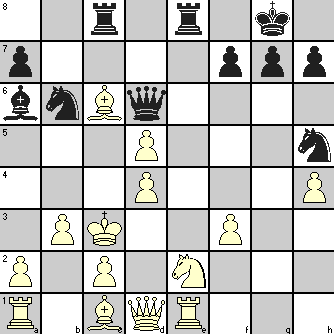You have seen the most common uses of a sacrifice in Chess Sacrifice as Chess Tactics, beginning with the most direct aim of ensnaring opponent’s King to less direct ones that help to create positions facilitating the march to that ultimate end. A successful sacrifice is an investment that brings you the win as a return on that investment.
This last article in the series (even though we may bring you more examples of the same ideas) on using sacrifices as chess tactics, we will just consider its plundering role. Here the attacker made investment of a sacrifice to recover after a stage enough material to compensate for the initial loss and by a general rule, a preponderance of material gives you enough advantage to win the game (excepting in some special situations). In such games, when the defender resigns considering his situation as hopeless, the commentators mostly sign off by saying ‘(… cannot avoid ruinous loss of material to save mate)!
However, since plundering is not the primary aim of sacrifice, the material gain is at best an indirect fall-out and you may have to remain satisfied with it at least for the time being. This happens when your main thrust to bring down the opponent’s King gets parried by your never-say-die opponent through such drastic measures as suffering significant material loss with a hope to fight another day!
In the example chosen, Black’s sacrifice (Rook against a Bishop) was aimed at cornering the King and creating checkmate. So he disdainfully rejects the opportunity for capturing the Queen, and makes the further offer of a Knight. When White realized that accepting the Knight meant immediate checkmate and rejecting the offer meant losing the Rook and Queen to the Knight without even the benefit of its capture, he gave up the fight!
The game was played between John Schulten and Paul Morphy at New Orleans in 1857.
John William Schulten (1821–1875) was a chess master of German origin from the United States. In the 1840s and 1850s, he traveled widely in Europe and the United States to play some of the best chess players in the world but ended up losing most of his games.
Paul Morphy (1837-1884) is a legend in chess history. He was a chess prodigy and was supposed to have learnt it by seeing others play. He became the US champion in 1857 and traveled to Europe to play most of the top players of his time and defeated all including Anderssen, but excepting Staunton who refused to play him. He was considered the strongest player of his time and the unofficial World Champion. But his effective chess career lasted for only about two years from 1857 to 1859. He tried to settle down in his chosen profession of law but his fame as a chess player possibly stood in his way to become a successful lawyer. He had his family fortune to support him but spent his remaining years in a kind of idleness as he refused to return to the world of chess. This may be the reason one of his biographers referred to him as the “pride and sorrow of chess”.
To quote GM Nigel Short on his views on the chess of Paul Morphy:
“We’re not talking rocket science here. It’s simple chess, but on a very high level. It’s easy to understand, but would you find the moves yourself? The answer is no. It is the speed at which Morphy develops that is so impressive, the way he gives up pawns to energize his position.”
As per GM Botvinnik:
“His mastery of open positions was so vast that little new has been learned about such positions after him.”
The diagram shows the board position after 18 moves have been completed.

| 19. | Kd2 | Rxc6! | ||
| 20. | dxc6 | Bxe2 | ||
| 21. | Rxe2 | Qxd4+ | ||
| 22. | Ke1 | Qg1+ | ||
| 23. | Kd2 | Rd8+ | ||
| 24. | Kc3 | Qc5+ | White Queen was there for the picking but Black had greater aims |
|
| 25. | Kb2 | Na4+ | White resigned. If 26. bxa4 then 26. … Qb4# If 26. Kb1 then 26. … Nc3+ 27. Kb2 Nxd1+ 28. Kb1 Nc3+ 29. Kb2 Nxe2 and White would be short by a Queen and a minor piece. |
Would you have any hesitation in agreeing with Grandmaster Short?
Watch the Game
httpv://www.youtube.com/watch?v=uKGFsR4l1Rc


7 Comments
White simply played bad PERIOD
The game is so old, at that time white had serious issues against this particular gambit. I read it in some magazine
video up
To be frank at human level King Gambit Accepted is rather a tricky one for white, he can lose the game easily, if he plays sensibly then he has some chances.
Paul M was such an attacking player. This is a great game.
@Sunny it was a decent game.
Beautiful display of tactics and combinations.
Trackbacks/Pingbacks